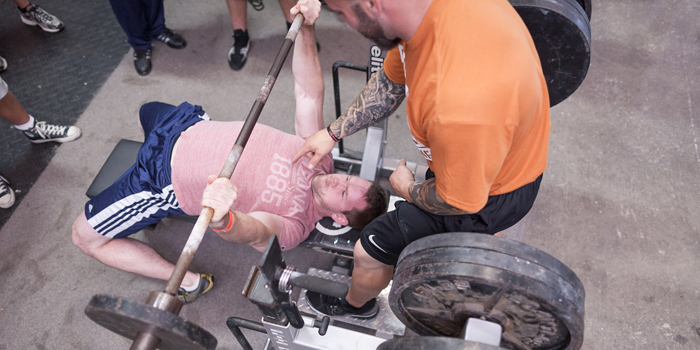
In six months time I was able to work up from a 500-pound equipped bench to a 600-pound equipped bench. There were no secret exercises or elaborate training programs, just consistent training and hard work. You would not catch me doing anything that hasn’t been done before in training. However, along the way I have learned some key techniques to benching that have been instrumental in my success.
If you’re looking to increase your bench press significantly, I highly suggest you try implementing what I’m about to share with you. It will make the difference.
My road to 600 can be broken down into two phases of training: the Raw Strength Phase and The Equipped Peaking Phase. Each phase had their own objectives and training techniques designed to bring me closer to my goal of 600.
Phase One — Raw Strength
The goal here was to focus on increasing my raw bench press. This is the surest way to increase your equipped bench pressing numbers. You know if you get 200 pounds out of your bench shirt from technique, you can either increase that technical gain or just get stronger overall. This phase is all about getting stronger overall. You can also call this phase the “offseason”. I hate using that term because I don’t believe you should take time off from training your body; you should always look to improve in any way you can.
WATCH: Table Talk — Training Tips to Break a Bench Press Plateau
When the goal is increasing raw strength, you need to implement training techniques a little differently than you would for equipped benching. Unlike equipped benching where you need to be strongest at lockout, with raw benching you need to display great strength off the chest for success. With that being said, there were many techniques I used in training during this time to build up my raw strength.
Paused Reps
Paused reps are a great way to build strength off the chest and anyone can implement this technique with minimal equipment. When you pause on the chest you are isometrically building strength in that bottom position. Pausing teaches you to stay tight with the bar. You will need to engage your lats and lower body in order to drive that bar off your chest after a 3-5 second pause. It also acts as a great tool to teach proper bottom position. If you have poor alignment of your joints in the bench press, this technique will bring light to that very quickly.
Increased Range of Motion Benching
By using a cambered bar such as a Duffalo Bar you can increase your range of motion on your bench press stroke. You are only as strong as the joint range of motion you utilize. When you increase your range of motion by an inch or two, you are effectively getting stronger in a disadvantageous position. When you return to benching with your usual range of motion you will find it easy in comparison. This technique works great with the added pauses I just talked about.
A Lot of Back Work
When you bench raw you don't have the support of the shirt to help you stabilize the weight on the descent. You need to build a big back and use your lats to control the bar down and give yourself a platform to press from. During this phase I would do some sort of back exercise almost every single training session. This will also have a great carry over to not only furthering your equipped benching significantly, but also benefitting your squat and deadlift. Having a big strong back is never a disadvantage!
WATCH: Table Talk — Lat Training to Build a Raw Bench Press
Attack Weak Points
After going through a training cycle you should have a good idea of your weak points. For me, my overhead press was very weak in comparison to my raw bench. It was an exercise I knew if I built up I would see an increase in my raw bench. With consistent progress overhead pressing, sure enough that was the exercise I needed to focus on to progress my raw bench. You may not have the same weak point as me but this is the phase in which you need to identify and attack your individual weaknesses.
Phase Two — Equipped Peaking
This phase marks the transition into peaking for the meet in the bench shirt. The ultimate goal is to take that raw strength that was just built and to transfer it into the equipment and dial in the shirted technique. The shirted training I used to peak for the meet was quite simple. I would just work down in boards as well as reps as the meet approached. It was very linear in its progression. The week before the meet I would take an opener to a half board and a third attempt to a one and a half board.
During the equipped peaking phase I trained a little differently than the raw phase and prioritized certain techniques. Unless they have been in a bench shirt before, people fail to understand that equipped benching is not as easy as just throwing the shirt on and benching 200-300 more pounds. The technique needs to be dialed in and you need to train specifically to handle much heavier weight with success. These are some of the training techniques I implied at this time to do just that.
Lockout Training
While raw benching requires strength off the chest to be successful, equipped benching requires the technique to lower the bar to the chest and the strength to lock out the weight. Lockout training needs to be prioritized. In my training, I used a lot of floor pressing with chains, shoulder saver benching with chains, and board work with bands. All these exercises did a great job of stressing that final punch through to lockout for me. I personally prefer the feel of bands for that final extension of the triceps but too much band pressing would beat up my elbows so I used it sparingly.
Bench Specific Back Work
I really kept the back work as specific to bench pressing as possible. By specific to the bench I mean doing rows in the same plane of motion and exercises such as the reverse band bench where you get into your setup on the bench and have the bar suspended from a rack by bands. Nothing is more specific than this and is great for an equipped bencher to get the feel of being able to bring a weight down to touch chest and pull your chest to the bar. I also used exercises such as a seated row with bands where I try to mimic the chest up shoulders back position, grab the lacrosse stick I was using with the same grip as my bench press, and touched chest with a hold in the same position I’d touch on bench. Exercises like these work the back in a way where it has a very good transfer over to how the back is used while benching. Just like in the previous phase, I did a lot of this specific back work.
Slingshot Benching
The slingshot is not only an awesome tool to overload the raw bench but it is particularly valuable for an equipped bencher. My third benching day of the week was a slingshot day where I mostly did cycles of 5x5’s with various slingshot tensions. This was part of my volume work and it worked well because the slingshot allows you to stay in a similar groove as the bench shirt, compared to the groove of just benching raw where it is usually more of a straight up and down motion. Of course you won’t handle as much weight in a slingshot as a bench shirt, so they are a great way to deload your shirt work while also getting some work in with your equipped benching groove.
Bamboo Bar
Bamboo bar work is something I kept in my training on a weekly basis for both phases. I did not miss a week with this bar. It is unbelievably valuable to shoulder health, but not only that. I found it to be a great tool for keeping the feel of lowering the weight with your lats. When I catch myself lowering this bar with kettlebells attached using my arms, the bar shakes a lot more and becomes hard to control. When I take my time and make sure I’m getting into my lats, the descent is very smooth and I stay in full control of the bar without much shaking. Over the course of the entire training cycle I was able to go from just a couple light kettlebells, to controlling multiple heavy kettlebells. It is a great bar to have at your disposal.
So there you have it! These are principles I swore by in my journey from a 500-pound bench to breaking through to a 600-pound bench. Nothing fancy, just smart consistent training. These are all things you can begin utilizing immediately to build a bigger bench.
Nick Benerakis is a strength coach at Gaglione Strength in Long Island NY. His best competition bench to date is 600 pounds multiply. Nick specializes in coaching the bench press. To learn more you can visit his website at bigbenchas.com or email him at coachben@bigbenchas.com.









